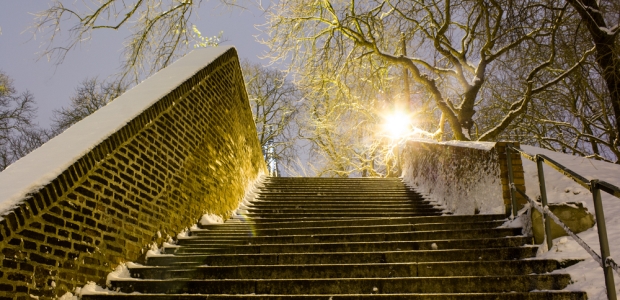
NYC Agency Helps Residents Prepare for Winter Weather
New York City's Office of Emergency Management posted winter weather advice to help the city's residents prepare for extreme cold, heavy snow, ice, sleet, and freezing rain and to stay safe throughout the season. The agency listed these steps to stay safe before, during, and after winter storms.
New York City's Office of Emergency Management posted winter weather advice to help the city's residents prepare for extreme cold, heavy snow, ice, sleet, and freezing rain and to stay safe throughout the season. The agency listed these steps to stay safe before, during, and after winter storms.
Prepare for Winter's Arrival:
- Make sure your household disaster plan is ready and all members of your household are familiar with how to contact one another in an emergency.
- Winterize your Go Bag by adding a blanket, warm socks, and gloves.
- Your emergency supply kit should be fully-stocked to allow you to sustain yourself for up to seven days without power or in the event you are unable to travel far from home. You may wish to include additional items such as extra blankets, additional warm clothing, and a battery-operated NOAA Weather Radio to monitor weather conditions during a storm.
Winterize Your Home:
- Install storm shutters, doors and windows; clean out gutters; repair any roof leaks; and have a contractor check the stability of your roof in the event of a large accumulation of snow.
- Insulate walls and attic. Caulk and weather-strip doors and windows. Install storm windows, or cover windows with plastic from the inside.
- Have safe emergency heating equipment available. For residences with functioning fireplaces, keep an ample supply of wood. Utilize portable electric space heaters. Keep a fire extinguisher on hand.
- Install and check batteries in smoke detectors and carbon monoxide detectors.
- Make sure you have sufficient heating fuel; you may have difficulty obtaining fuel in the immediate aftermath of a bad storm.
- Service snow removal equipment and have rock salt on hand to melt ice on walkways. Kitty litter can be used to generate temporary traction.
Winterize Your Car:
Before winter sets in, have a mechanic check the following items on your vehicle:
- Battery
- Antifreeze
- Windshield wipers and washer fluid
- Ignition system
- Thermostat
- Lights (headlamps and hazard lights)
- Exhaust system, heater, brakes, defroster
- Oil level (if necessary, replace oil with a winter oil or SAE 10w/30 variety)
Install good winter tires that have adequate tread. All-weather radials are usually adequate for most winter conditions. However, some jurisdictions require vehicles to be equipped with chains or snow tires with studs.
Regardless of the season, it's a good idea to prepare for an in-car emergency. Assemble an emergency supply kit for your vehicle, and consider adding the following items for winter conditions:
- Blankets, sleeping bags, extra newspapers for insulation
- Plastic bags (for sanitation)
- Extra mittens, socks, scarves and hat, raingear and extra clothes
- Sack of sand or kitty litter for gaining traction under wheels, small shovel
- Set of tire chains or traction mats
- Working jack and lug wrench, spare tire
- Windshield scraper, broom
- Small tools (pliers, wrench, screwdriver)
- Booster cables
- Brightly colored cloth to use as a flag, flares or reflective triangles
What to Do Before a Storm Strikes:
- Listen to NOAA Weather Radio and your local radio and TV stations for updated storm information. Know what winter storm watches and warnings mean.
- Check on relatives, friends, and neighbors who may need assistance preparing for a storm.
- Be alert to changing weather conditions and avoid unnecessary travel.
- Let faucets drip a little to help prevent freezing.
- Test smoke detectors and carbon monoxide detectors.
Know the Terms:
- Freezing Rain: rain that freezes when it hits the ground, creating a coating of ice on roads, walkways, trees, and power lines.
- Frost/Freeze Warning: issued when temperatures are expected to drop below freezing over a large area for an extended period of time.
- Sleet: rain that turns to ice pellets before reaching the ground. Sleet also causes moisture on roads to freeze and become slippery.
- Ice Storm: when ice accumulations are expected during freezing rain situations. Significant ice accumulations are usually 1/4 of an inch or greater.
- Wind Chill: the temperature it "feels like" when you are outside.
- Heavy Snow: snowfall accumulating to 4 inches or more in depth in 12 hours or less; or snowfall accumulating to 6 inches or more in depth in 24 hours or less.
- Winter Weather Advisory: issued by the National Weather Service when a combination of winter weather (snow, freezing rain, sleet, etc.) may present a hazard, but does not meet warning criteria.
- Winter Storm Watch: issued by the National Weather Service when there is a potential for heavy snow or significant ice, usually at least 24 to 36 hours in advance. The criteria for this watch can vary from place to place.
- Winter Storm Warning: issued by the National Weather Service when a winter storm is producing or is forecast to produce heavy snow or significant ice. The criteria for this warning can vary from place to place.
- Blizzard Warning: issued by the National Weather Service for winter storms with sustained or frequent winds of 35 mph or higher with considerable falling and/or blowing snow that frequently reduces visibility to 1/4 of a mile or less. These conditions are expected to last for a minimum of three hours.